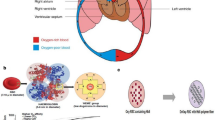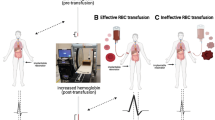Abstract
Blood substitutes are being developed as a temporary replacement fluid and oxygen carrier for patients with severe blood loss due to trauma, shock or combat casualty (1,2). These substitutes are not meant to replace blood for they do not have properties bestowed by white blood cells, platelets and other plasma factors. Within the field of blood substitute research, there is a great need for developing techniques to determine the effectiveness of various blood substitutes in relationship to their ability to pick up oxygen as it passes through the lungs or deliver oxygen when it reaches the tissues. These comparisons must be performed to monitor the effectiveness of the various substitutes between each other or as a group against the native oxygen carrier, red blood cells (RBC). For widespread use, these methods to determine effectiveness in relationship to oxygen transport properties must be relatively non-invasive and physiologic, as well as applicable to human patients by being easy to perform in a clinical setting and use non-toxic agents. Moreover, these techniques must be able to distinguish the tissue oxygenation by the blood substitute in the presence of other oxygen carriers, namely RBC. Many techniques including frozen myocardial spectroscopy, microelectrodes, phosphorescence quenching, magnetic resonance spectroscopy, near-infrared spectroscopy, NADH fluorescence and electron spin resonance have been summarized for their usefulness in assessing oxygenation either directly or indirectly by Wagner and Scheid (3).
Access this chapter
Tax calculation will be finalised at checkout
Purchases are for personal use only
Preview
Unable to display preview. Download preview PDF.
Similar content being viewed by others
References
Winslow RM. Blood substitutes. Science & Medicine 1997;4:54–63.
Rudolph AS. Liposome encapsulated hemoglobin. In: Winslow RM, Vandergriff KD, Intagiletta M, ed. Blood Substitutes: Physiological Basis of Efficacy. Boston: Birkhauser, 1995: 90–104.
Wagner PD, Scheid P. Methods for measuring levels of O2 in tissues. In: Hogan MC, Mathieu-Costello O, Poole DC, Wagner PD, ed. Oxygen Transport to Tissue XVI. New York: Plenum, 1994: 371–374.
Berridge MS, Terris AH, Cassidy EH. Low-carrier production of [l5O]oxygen, water and carbon monoxide. Appl Radiat Isot 1990;41:l 173–1175.
Cherry SE, Phelps ME. Positron emission tomography: Methods and instrumentation. In: Sandler MP, Coleman RE, Wackers FJT, Patton JA, Gottschalk A, Hoffer PB, ed. Diagnostic Nuclear Medicine. Baltimore MD: Williams & Wilkins, 1996: 139–159. vol 1).
Hoffman JM, Hanson MW, Coleman RE. Clinical positron emission tomography imaging. Radiologic Clinics of North America1993;31:935–959.
Raichle ME. Visualizing the mind. Scientific American 1994;270(4):58–64.
Ter-Pogossian MM, Eichung JO, Davis DO, Welch MJ. The measure in vivo of regional cerebral oxygen utilization by means of oxyhemoglobin labeled with radioactive oxygen-15. J Clin Invest 1970;49:381–391.
Phillips WT, Lernen L, Goins B, et al. Use of oxygen-15 to measure oxygen-carrying capacity of blood substitutes in vivo. American Journal of Physiology 1997; 272:H2492–H2499.
Tomita S, Enoki Y, Yoshida H, Yasumitsu Y A simple spectrophotometric method for determination of methemoglobin in dilute solutions. J Nara Med Assoc 1968; 19:1–41.
Vandegriff KD, Winslow RM. The theoretical analysis of oxygen transport: A new strategy for the design of hemoglobin-based red cell substitutes. In: Winslow RM, Vandegriff KD, Intaglietta M, ed. Blood Substitutes: Physiological Basis of Efficacy. Boston: Birkhauser, 1995: 143–154.
Meyer GJ, Waters SL, Coenen HH, Luxen A, Maziere B, Langstrom B. PET radiopharmaceuticals in Europe: Current use and data relevant for the formulation of summaries of product characteristics. Eur J Nucl Med 1995;22:1420–1432.
Ghosh PR. The international state of PET. J Nucl Med 1991;32:28N–51N.
Author information
Authors and Affiliations
Editor information
Editors and Affiliations
Rights and permissions
Copyright information
© 1998 Springer Science+Business Media New York
About this chapter
Cite this chapter
Goins, B. et al. (1998). Use of Oxygen-15-Labeled Molecular Oxygen for Oxygen Delivery Studies of Blood and Blood Substitutes. In: Hudetz, A.G., Bruley, D.F. (eds) Oxygen Transport to Tissue XX. Advances in Experimental Medicine and Biology, vol 454. Springer, Boston, MA. https://doi.org/10.1007/978-1-4615-4863-8_76
Download citation
DOI: https://doi.org/10.1007/978-1-4615-4863-8_76
Publisher Name: Springer, Boston, MA
Print ISBN: 978-1-4613-7206-6
Online ISBN: 978-1-4615-4863-8
eBook Packages: Springer Book Archive




